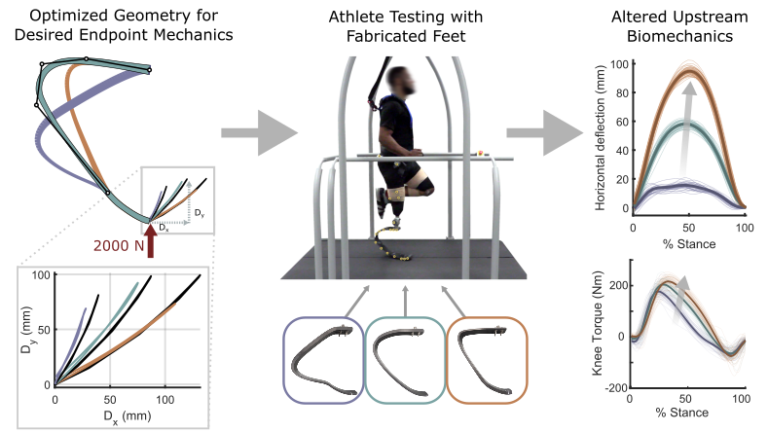Running-Specific Prostheses, or “blades,” are curved leaf springs, constructed from a composite of carbon-fiber and epoxy resin, and designed to emulate the spring-like nature of the leg during running. These feet have enabled athletes with amputations to run at levels comparable to many of the fastest runners with biological legs. Researchers have tried, with limited success, to improve these feet further by uncovering the map between prosthesis mechanics and athlete performance.
This pursuit has partially been hindered by overly simplified description of blade behavior. The endpoint deflections are typically not co-linear with the applied force; an accurate description of the foot’s displacement to a vertical force requires three components, namely horizontal, vertical, and angular deflections. In particular, horizontal deflection, which is often neglected, could substantially affect the location of the center of pressure relative to the rest of the leg, resulting in different forces and torques borne by the prosthetic socket, knees, and hips.
Since increasing overall blade thickness similar affects all three components of deflection (akin to increasing prosthesis “category”), how would a prosthesis designer devise the correct blade shape for given endpoint mechanics? To solve this, we developed a spline-based shape optimization to find shapes that would achieve target mechanics. The optimization adheres to practical constraints while manipulating spline control points and taper parameters to minimize deviations from the desired toe deflection (vertical, horizontal, and angular). To illustrate the value of this technique, we designed, manufactured, and had an athlete test three blades with identical vertical and angular deflections but varied horizontal deflections, validating our hypothesis that knee moments would increase with increased horizontal displacement of the toe. The results in this manuscript provide validation for our parameterization of endpoint mechanics, optimization methodology, and strategy for improving running performance by precise and methodical variation of blade mechanics.

